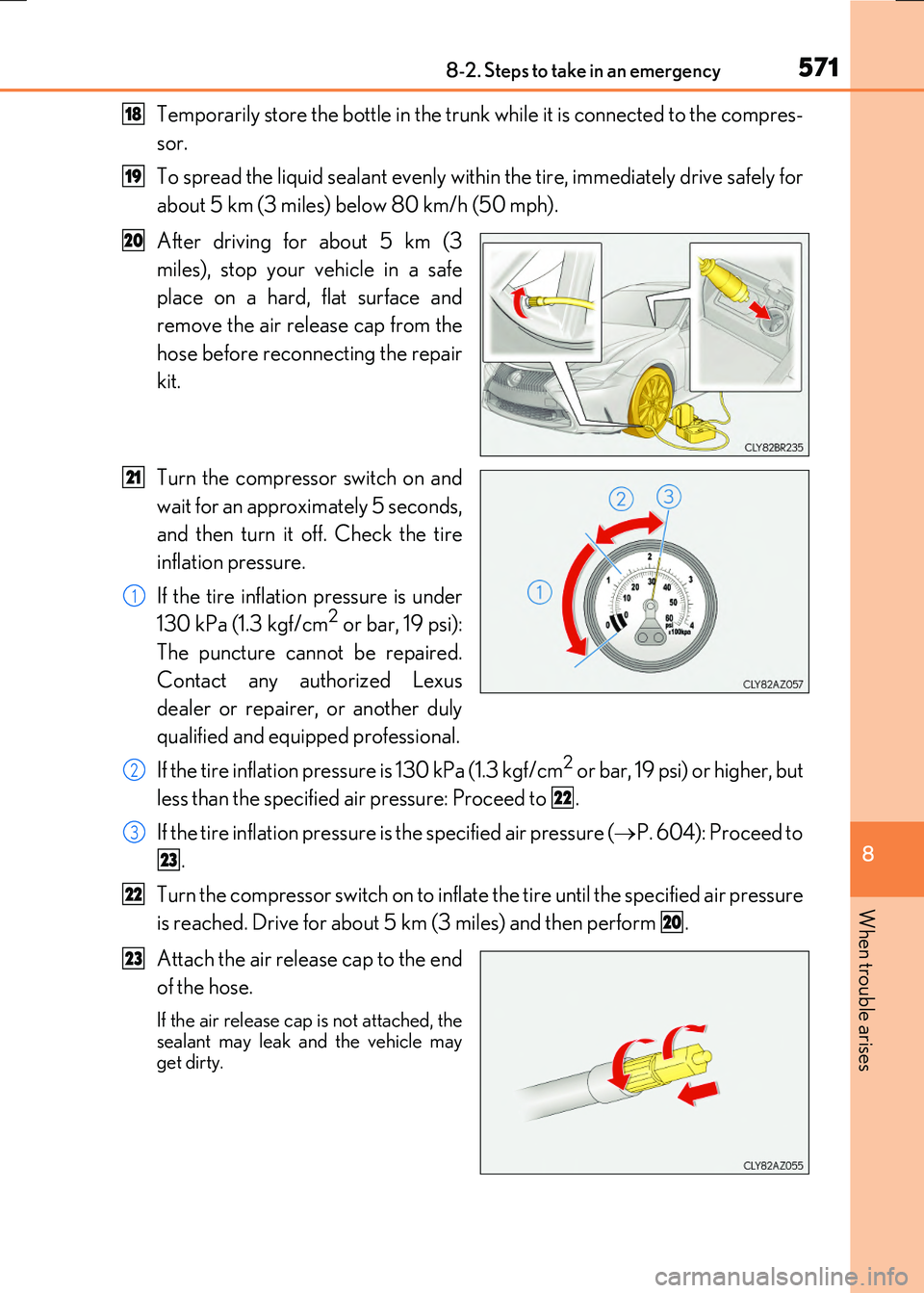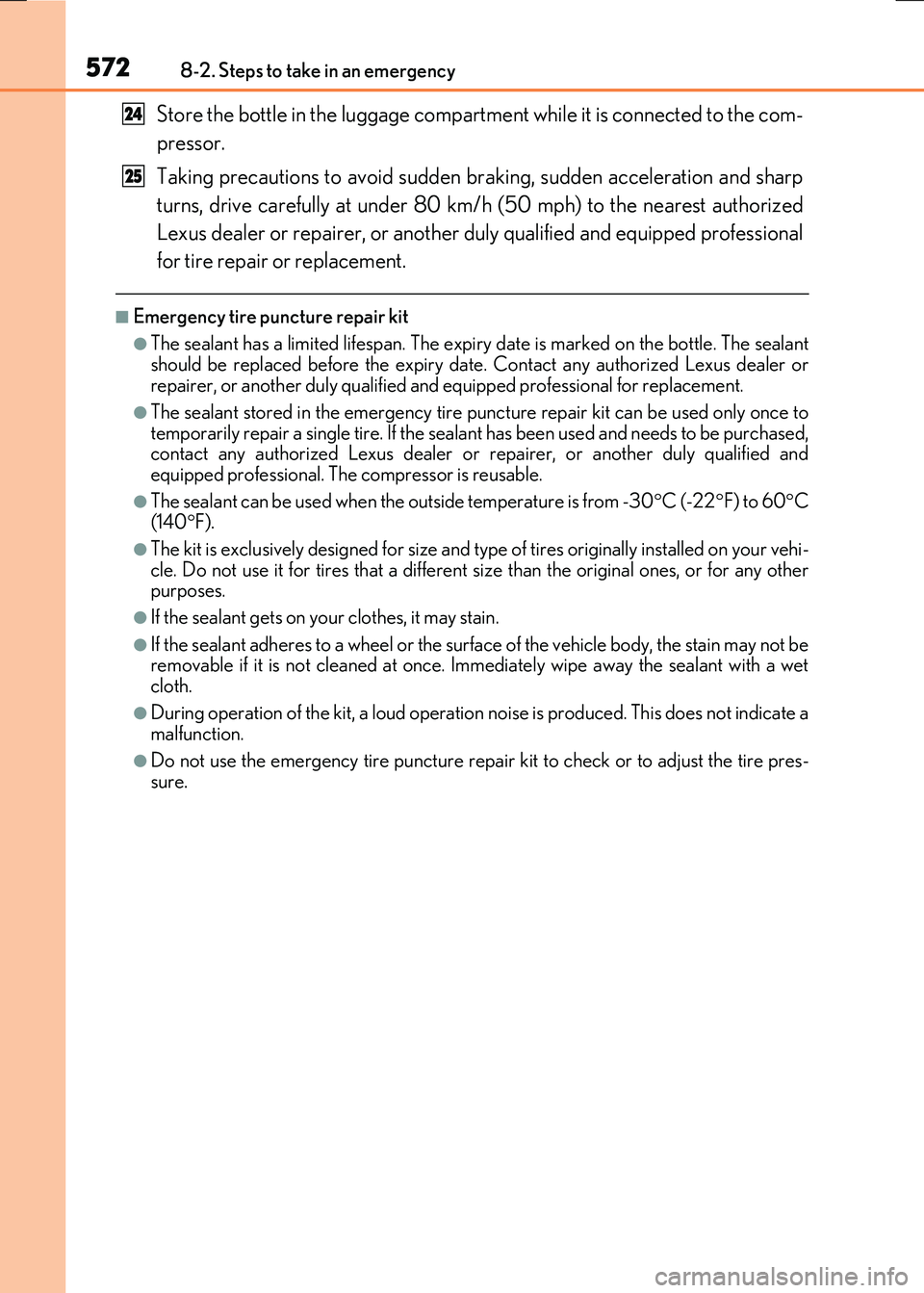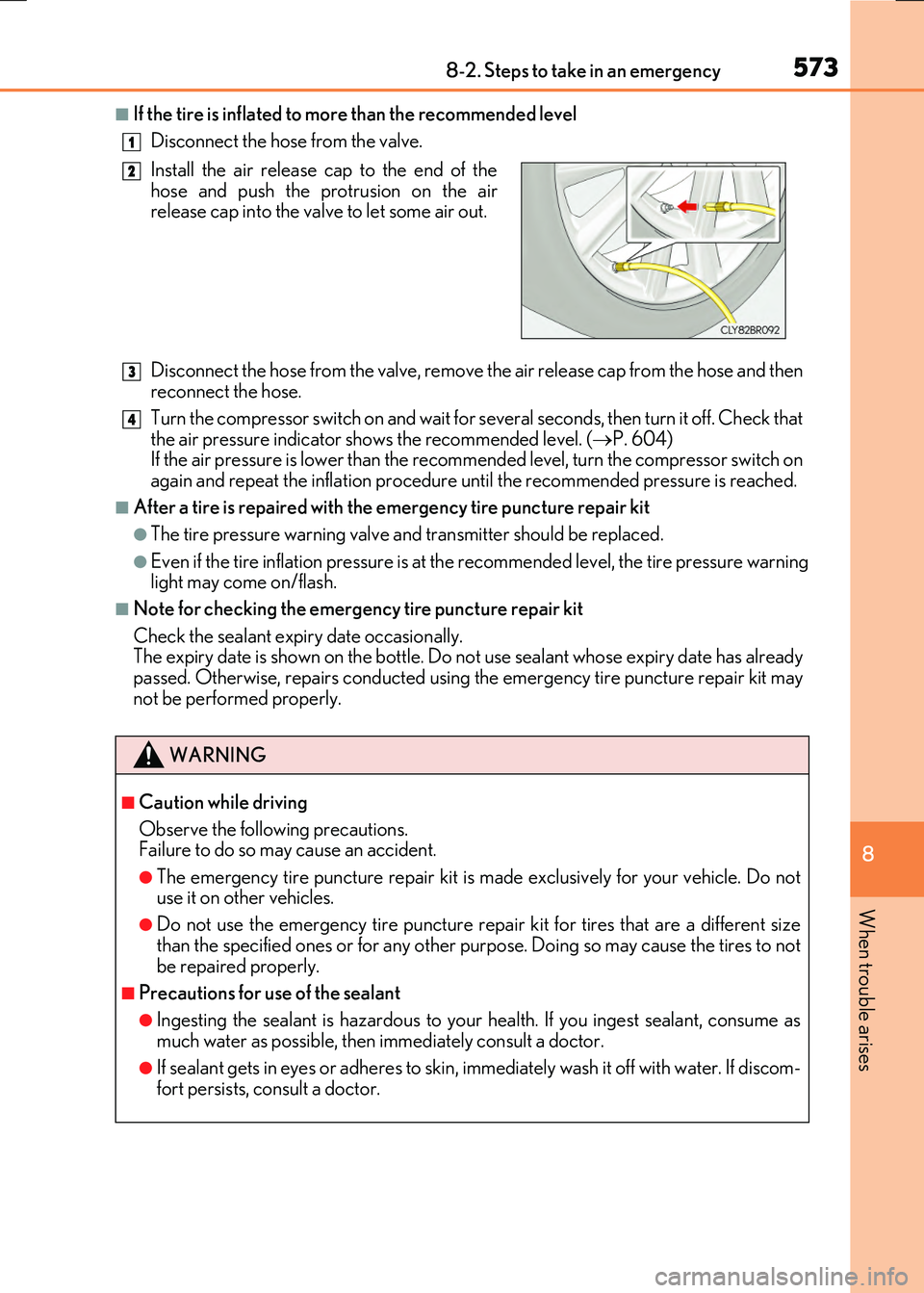Page 566 of 640
5668-2. Steps to take in an emergency
RC300h_EE(OM24740E)
Remove the 12-volt battery cover.
Remove the band and take out the
emergency tire puncture repair kit.
Taking out the emergency tire puncture repair kits
1
2
Page 567 of 640
5678-2. Steps to take in an emergency
8
When trouble arises
RC300h_EE(OM24740E)
Take out the repair kit from the tool box.
Remove the valve cap from the valve
of the punctured tire.
Remove the protective film from the
bottle and extend the hose. Remove
the air release cap from the hose.
Attach the sticker enclosed with the bot- tle on the specified locations. (See step
9.)
You will use the air release cap again. Therefore keep it in a safe place.
Connect the hose to the valve.
Screw the end of the hose clockwise asfar as possible.
Make sure that the compressor
switch is off.
Emergency repair method
1
2
3
4
5
Page 568 of 640
5688-2. Steps to take in an emergency
RC300h_EE(OM24740E)
Remove the power plug from the
compressor.
Connect the power plug to the power outlet socket. ( P. 456)
Remove the sticker.
Attach the 2 stickers as shown.
Remove any dirt and moisture from the
wheel before attaching the label. If it is impossible to attach the label, make sureto tell any authorized Lexus dealer or
repairer, or another duly qualified and equipped professional when you havethem repair and replace the tire that
sealant is injected.
6
7
8
9
Page 570 of 640

5708-2. Steps to take in an emergency
RC300h_EE(OM24740E)
Inflate the tire until the specified air
pressure is reached.
The sealant will be injected and the
pressure will surge and then gradu-
ally decrease.
The air pressure gauge will display
the actual tire inflation pressure
about 1 minute (5 minutes at low
temperature) after the switch is
turned on.
Inflate the tire until the specified air
pressure.
• Turn the compressor switch off and
then check the tire inflation pressure.
Being careful not to over inflate,
check and repeat the inflation pro-
cedure until the specified tire infla-
tion pressure is reached.
• If the tire inflation pressure is still lower than the specified point after inflation
for 35 minutes with the switch on, the ti re is too damaged to be repaired. Turn
the compressor switch off and contact any authorized Lexus dealer or
repairer, or another duly qualified and equipped professional.
• If the tire inflation pressure exceeds th e specified air pressure, let out some air
to adjust the tire inflation pressure. ( P. 573, 604)
With the compressor switch off, disconne ct the hose from the valve on the tire
and then pull out the power plug from the power outlet socket.
Some sealant may leak wh en the hose is removed.
Install the valve cap onto the valve of the emergency repaired tire.
Attach the air release cap to the end
of the hose.
If the air release cap is not attached, the sealant may leak and the vehicle may
get dirty.
14
1
2
3
15
16
17
Page 571 of 640

5718-2. Steps to take in an emergency
8
When trouble arises
RC300h_EE(OM24740E)
Temporarily store the bottle in the trunk while it is connected to the compres-
sor.
To spread the liquid sealant evenly within the tire, immediately drive safely for
about 5 km (3 miles) below 80 km/h (50 mph).
After driving for about 5 km (3
miles), stop your vehicle in a safe
place on a hard, flat surface and
remove the air release cap from the
hose before reconnecting the repair
kit.
Turn the compressor switch on and
wait for an approximately 5 seconds,
and then turn it off. Check the tire
inflation pressure.
If the tire inflation pressure is under
130 kPa (1.3 kgf/cm
2 or bar, 19 psi):
The puncture cannot be repaired.
Contact any authorized Lexus
dealer or repairer, or another duly
qualified and equipped professional.
If the tire inflation pressure is 130 kPa (1.3 kgf/cm
2 or bar, 19 psi) or higher, but
less than the specified air pressure: Proceed to .
If the tire inflation pressure is the specified air pressure ( P. 604): Proceed to
.
Turn the compressor switch on to inflate the tire until the specified air pressure
is reached. Drive for about 5 km (3 miles) and then perform .
Attach the air release cap to the end
of the hose.
If the air release cap is not attached, the
sealant may leak and the vehicle may
get dirty.
18
19
20
21
1
2
22
3
23
22
20
23
Page 572 of 640

5728-2. Steps to take in an emergency
RC300h_EE(OM24740E)
Store the bottle in the luggage compartment while it is connected to the com-
pressor.
Taking precautions to avoid sudden br aking, sudden acceleration and sharp
turns, drive carefully at under 80 km/h (50 mph) to the nearest authorized
Lexus dealer or repairer, or another duly qualified and equipped professional
for tire repair or replacement.
■Emergency tire puncture repair kit
●The sealant has a limited lifespan. The expiry date is marked on the bottle. The sealant
should be replaced before the expiry da te. Contact any authorized Lexus dealer or repairer, or another duly qualified an d equipped professional for replacement.
●The sealant stored in the emergency tire puncture repair kit can be used only once to
temporarily repair a single tire. If the seal ant has been used and needs to be purchased, contact any authorized Lexus dealer or repairer, or another duly qualified andequipped professional. The compressor is reusable.
●The sealant can be used when the outside temperature is from -30 C (-22F) to 60C (140 F).
●The kit is exclusively designed for size and type of tires originally installed on your vehi-
cle. Do not use it for tires that a different size than the original ones, or for any other purposes.
●If the sealant gets on your clothes, it may stain.
●If the sealant adheres to a wheel or the surface of the vehicle body, the stain may not beremovable if it is not cleaned at once. Immediately wipe away the sealant with a wetcloth.
●During operation of the kit, a loud operatio n noise is produced. This does not indicate a malfunction.
●Do not use the emergency tire puncture repair kit to check or to adjust the tire pres-
sure.
24
25
Page 573 of 640

5738-2. Steps to take in an emergency
8
When trouble arises
RC300h_EE(OM24740E)
■If the tire is inflated to more than the recommended level
Disconnect the hose from the valve.
Disconnect the hose from the valve, remove the air release cap from the hose and then reconnect the hose.
Turn the compressor switch on and wait for several seconds, then turn it off. Check that the air pressure indicator sh ows the recommended level. (P. 604) If the air pressure is lower than the reco mmended level, turn the compressor switch on
again and repeat the inflation procedure un til the recommended pressure is reached.
■After a tire is repaired with the emergency tire puncture repair kit
●The tire pressure warning valve and transmitter should be replaced.
●Even if the tire inflation pressure is at the recommended level, the tire pressure warning light may come on/flash.
■Note for checking the emergency tire puncture repair kit
Check the sealant expiry date occasionally. The expiry date is shown on the bottle. Do not use sealant whose expiry date has alreadypassed. Otherwise, repairs conducted using th e emergency tire puncture repair kit may
not be performed properly.
Install the air release cap to the end of the hose and push the protrusion on the airrelease cap into the valve to let some air out.
WARNING
■Caution while driving
Observe the following precautions. Failure to do so may cause an accident.
●The emergency tire puncture repair kit is made exclusively for your vehicle. Do notuse it on other vehicles.
●Do not use the emergency tire puncture repa ir kit for tires that are a different size
than the specified ones or fo r any other purpose. Doing so may cause the tires to not be repaired properly.
■Precautions for use of the sealant
●Ingesting the sealant is hazardous to your health. If you ingest sealant, consume asmuch water as possible, then immediately consult a doctor.
●If sealant gets in eyes or adheres to skin, immediately wash it off with water. If discom-
fort persists, consult a doctor.
1
2
3
4
Page 574 of 640

5748-2. Steps to take in an emergency
RC300h_EE(OM24740E)
WARNING
■When fixing the flat tire
Observe the following precautions. Failure to do so may result in death or serious injury.
●Stop your vehicle in a safe and flat area.
●Do not touch the wheels or the area around the brakes immediately after the vehicle has been driven.
After the vehicle has been driven, the wheels and the area around the brakes may be extremely hot. Touching these areas with hands, feet or other body parts may result inburns.
●Connect the valve and hose securely with the tire installed on the vehicle.
• If the hose is not properly connected to the valve, air leakage may occur or sealant may be sprayed out.
• If the hose comes off the valve while inflating the tire, there is a risk that the hose will move abruptly due to air pressure.• After inflation of the tire has completed, the sealant may splatter when the hose is
disconnected or some air is let out of the tire.
●Follow the operation procedure to repair the tire. If the procedure is not followed, the
sealant may spray out.
●Keep back from the tire while it is being repaired, as there is a chance of it bursting while the repair operation is being performe d. If you notice any cracks or deforma-
tion of the tire, turn off the compressor sw itch and stop the repair operation immedi- ately.
●The kit may overheat if operated for a long period of time. Do not operate the com-
pressor continuously for more than 35 minutes.
●Parts of the kit become hot during operatio n. Be careful handling the kit during and after operation. Do not touch the metal part around the connecting area between the
bottle and compressor. It will be extremely hot.
●Do not attach the vehicle speed warning sticker to an area other than the one indi- cated. If the sticker is attached to an area where an SRS airbag is located, such as the
pad of the steering wheel, it may preven t the SRS airbag from operating properly.
■Driving to spread the liquid sealant evenly
●Drive the vehicle carefully at a low speed. Be especially careful when turning and cor-
nering.
●If the vehicle does not drive straight or you feel a pull through the steering wheel, stop the vehicle and check the following:
• Tire condition. The tire may have separated from the wheel. • Tire inflation pressure. If tire inflation pressure is 130 kPa (1.3 kgf/cm2 or b ar, 1 9 p si)or below, this may indica te severe tire damage.